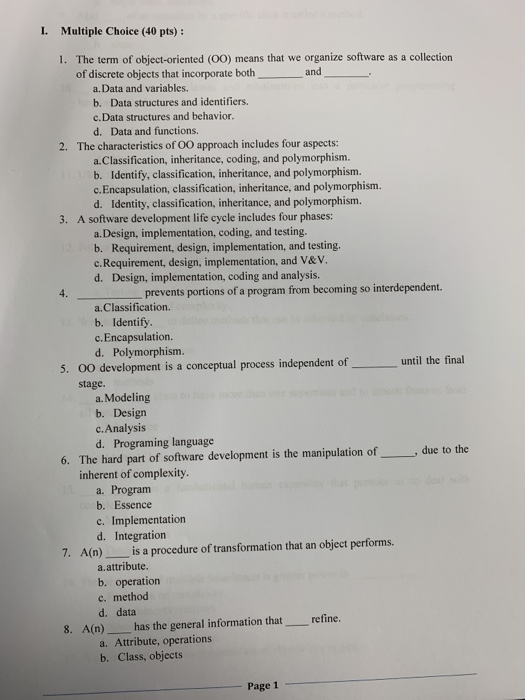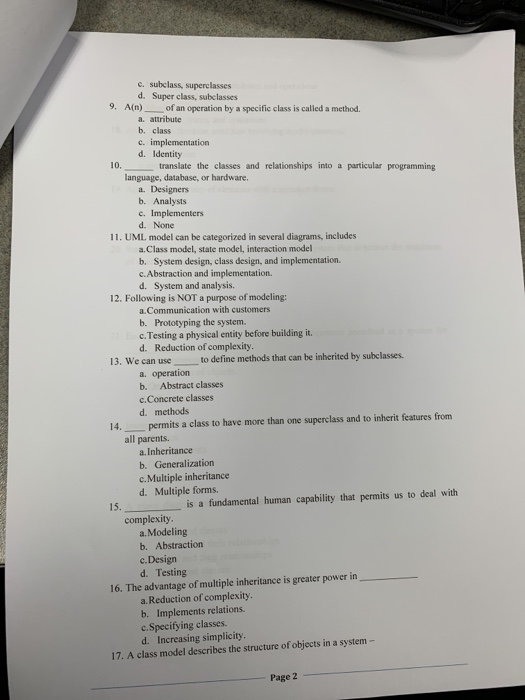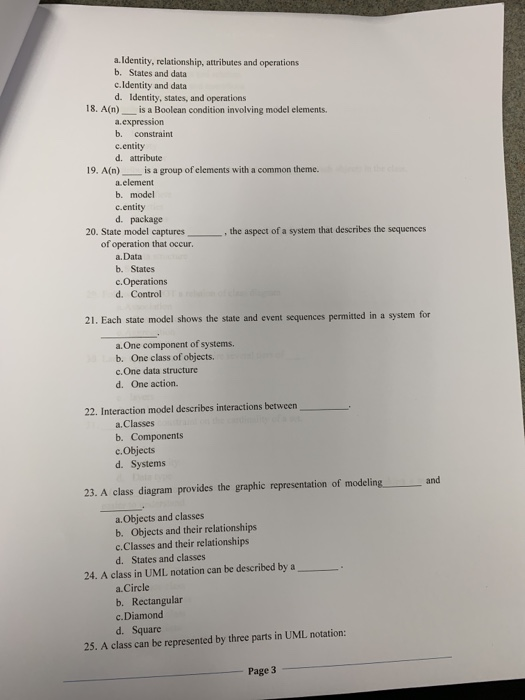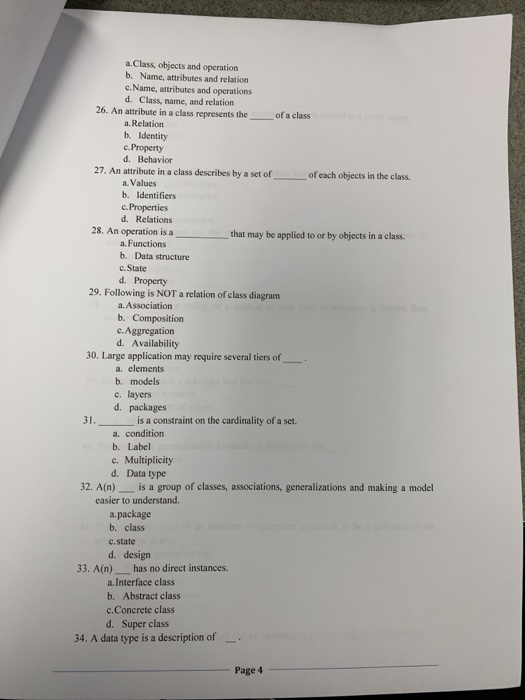I. Multiple Choice (40 pts): 1. The term of object-oriented (00) means that we organize software as a collection of discrete objects that incorporate both and a. Data and variables. b. Data structures and identifiers. c. Data structures and behavior. d. Data and functions. 2. The characteristics of O0 approach includes four aspects: a.Classification, inheritance, coding, and polymorphism. b. Identify, classification, inheritance, and polymorphism. c.Encapsulation, classification, inheritance, and polymorphism. d. Identity, classification, inheritance, and polymorphism. 3. A software development life cycle includes four phases: a.Design, implementation, coding, and testing. b. Requirement, design, implementation, and testing. c. Requirement, design, implementation, and V&V d. Design, implementation, coding and analysis. prevents portions of a program from becoming so interdependent. a Classification. b. Identify c. Encapsulation. d. Polymorphism. s. 00 development is a conceptual process independent ofuntil the final stage. a.Modeling b. Design c.Analysis d. Programing language 6. The hard part of software development is the manipulation of due to the inherent of complexity a. Programm b. Essence c. Implementation d. Integration 7. A(m) is a procedure of transformation that an object performs. a. attribute b. operation c. method d. data 8. A(n) has the general information that refine. a. Attribute, operations b. Class, objects Page 1 c. subelass, superclasses d. Super class, subclasses 9. A(n) of an operation by a specific class is called a method. a. attribute b. class c. implementation d. Identity 1 0, translate the classes and relationships into a particular programming language, database, or hardware. a. Designers b. Analysts c.Implementers d. None 11. UML. model can be categorized in several diagrams, includes a.Class model, state model, interaction model b. System design, class design, and implementation. c.Abstraction and implementation. d. System and analysis. 12. Following is NOT a purpose of modeling: a Communication with customers b. Prototyping the system. c. Testing a physical entity before building it. d. Reduction of complexity 13. We can use to define methods that can be inherited by subclasses. a. operation b. Abstract classes c. Concrete classes d. methods 14. permits a class to have more than one superclass and to inherit features from all parents. b. Generalization c. Multiple inheritance d. Multiple forms. 15. is a fundamental human capability that permits us to deal with complexity a.Modeling b. Abstraction c. Design d. Testing 16. The advantage of multiple inheritance is greater power in a. Reduction of complexity. b. Implements relations c.Specifying classes. d. Increasing simplicity. 17. A class model describes the structure of objects in a system - Page 2 a.Identity, relationship, attributes and operations b. States and data c.Identity and data d. Identity, states, and operations 18. A(n)--is a Boolean condition involving model elements. a.expression b. constraint c.entity d. attribute 19. A(n)is a group of elements with a common theme. a element b. model c.entity d. package 20. State model captures the aspect of a system that describes the sequences of operation that occur a.Data b. States c.Operations d. Control 21. Each state model shows the state and event sequences permitted in a system for a.One component of systems b. One class of objects. c.One data structure d. One action. 22. Interaction model describes interactions between a. Classes b. Components c.Objects d. Systems and 23. A class diagram provides the graphic representation of modeling a. Objects and classes b. Objects and their relationships c.Classes and their relationships d. States and classes 24. A class in UML notation can be described bya a.Circle b. Rectangular c. Diamonod d. Square 25. A class can be represented by three parts in UML notation: Page 3 a.Class, objects and operation b. Name, attributes and relation c.Name, attributes and operations Class, name, and relation 26. An attribute in a class represents theo d. a class a Relatiorn b. Identity c.Property d. Behavior 27. An attribute in a class describes by a set of of each objects in the class. a. Values b. Identifiers e.Properties d. Relations 28. An operation is a that may be applied to or by objects in a class. a. Functions b. Data structure c. State d. Property 29. Following is NOT a relation of class diagram a. Association b. Composition c.Aggregation d. Availability 30. Large application may require several tiers of a. elements b. models c. layers d. packages 31 is a constraint on the cardinality of a set. a. condition b. Label c. Multiplicity d. Data type 32. A(n) is a group of classes, associations, generalizations and making a model easier to understand. a.package b. class c.state d. design 33. A(n) has no direct instances a. Interface class b. Abstract class c.Concrete class d. Super class 34. A data type is a description of Page 4










